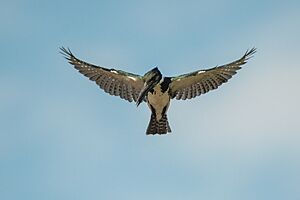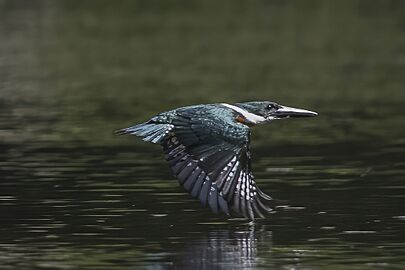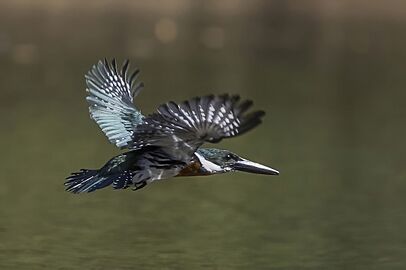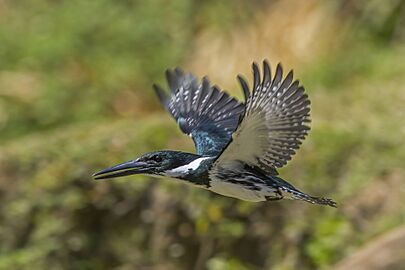Amazon kingfisher facts for kids
Quick facts for kids Amazon kingfisher |
|
|---|---|
 |
|
| A male at Iberá Wetlands, Corrientes Province, Argentina | |
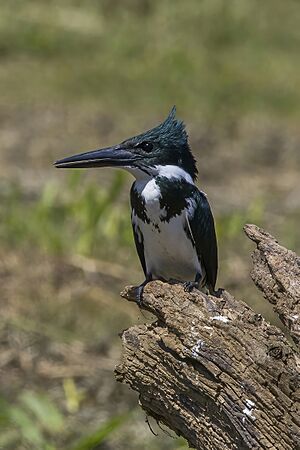 |
|
| A female at San Ignacio, Belize | |
| Conservation status | |
| Scientific classification | |
| Genus: |
Chloroceryle
|
| Species: |
amazona
|
 |
|
The Amazon kingfisher (Chloroceryle amazona) is a cool bird that belongs to the "water kingfisher" group. You can find it in warm, tropical areas of the Americas. It lives from southern Mexico all the way south through Central America to northern Argentina.
Contents
About the Amazon Kingfisher
Scientists first officially described the Amazon kingfisher in 1790. An English bird expert named John Latham gave it the scientific name Alcedo amazona. Later, in 1848, another scientist named Johann Jakob Kaup placed it in its current group, Chloroceryle. This bird is considered a "monotypic" species, which means it's the only one of its kind in its group.
What Does it Look Like?
The Amazon kingfisher is about 30 centimeters (12 inches) long. Males usually weigh between 98 and 121 grams (3.5 to 4.3 ounces). Females are a bit heavier, weighing from 125 to 140 grams (4.4 to 4.9 ounces).
It has the classic kingfisher shape, with a spiky crest of feathers on its head. It also has a long, strong beak that is black. The bottom part of its beak has a little pale yellow. Its legs and feet are dark gray.
Adult male kingfishers have dark, shiny green feathers on their backs and wings. A white band goes around their neck like a collar. Their chin and throat are white, and they have a bright reddish-brown chest. The sides of their body are dark green, and their belly is white with dark green stripes.
Adult females look a bit different. They don't have the reddish-brown chest. Instead, the green color from their sides spreads across their chest almost to the middle.
Young male kingfishers have a light reddish-brown chest. Both young males and females have light yellow spots on their upper wing feathers. They also have a large yellow patch on their beak.
Where Do Amazon Kingfishers Live?
You can find the Amazon kingfisher in many places! In Mexico, it lives in states like Sinaloa and Tamaulipas. From there, it spreads south through Central America into Colombia and Venezuela. East of the Andes mountains, it lives in almost every South American country, reaching as far south as central Argentina.
Sometimes, these birds travel to places like Aruba, Trinidad, and even Texas in the United States.
They love to live near large rivers, whether the water moves slowly or quickly. They also like the wooded edges of lakes and freshwater ponds. Occasionally, you might see them in salty lagoons, mangrove swamps, or areas where rivers meet the sea. They prefer open areas rather than thick forests.
Most Amazon kingfishers live below 1,200 meters (about 3,900 feet) in elevation. However, in Venezuela, they can be found as high as 2,500 meters (about 8,200 feet).
How Amazon Kingfishers Behave
Do They Move Around?
Most people think Amazon kingfishers stay in one place their whole lives. However, there have been times when they've been seen far from their usual homes.
What Do They Eat?
The Amazon kingfisher is a skilled hunter! It usually sits on a branch or other spot above the water. From there, it dives headfirst into the water to catch its food. Sometimes, it might hover in the air for a moment before diving.
Their diet is mostly fish, especially a type of fish called Characidae. They also enjoy eating crustaceans, like crabs or shrimp.
How Do They Raise Their Young?
The breeding season for Amazon kingfishers changes depending on where they live. In Central America, it's usually in the first half of the year.
Both the male and female work together to dig a nest. They make a slightly sloped tunnel in a river bank or a similar dirt wall. The tunnel can be up to 1.6 meters (about 5 feet) long. At the very end of the tunnel, they dig a special chamber for the nest.
A female kingfisher usually lays three or four eggs. The female does most of the egg sitting at night. During the day, the male takes over. The eggs hatch after about 22 days. The young birds are ready to fly and leave the nest about 29 to 30 days after they hatch.
What Sounds Do They Make?
The Amazon kingfisher makes several different sounds. You might hear a loud, rough sound like "tek" or "klek," which they repeat. They also make a quick, choppy sound like "chrit" that can turn into a rattling noise. Some of their calls even sound like frogs!
Another call they make is a series of clear notes that get faster, like "see see see...su su su su." Scientists think this sound might be a greeting or an alarm call to warn others.
Conservation Status
The IUCN (International Union for Conservation of Nature) has looked at the Amazon kingfisher's status. They have listed it as "Least Concern." This means that the bird is not currently in danger of disappearing.
It lives across a very large area. Scientists estimate there are at least half a million adult birds. However, this number is thought to be slowly going down. Luckily, no immediate big threats have been found for the Amazon kingfisher.



